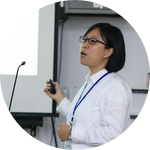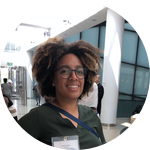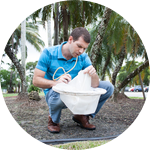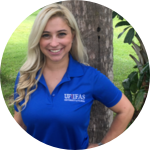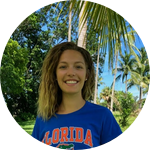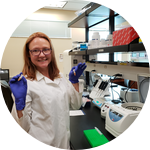About This Project
Florida is a hot spot for invasive species due to its subtropical climate and geographic location. These invasive species often cause enormous economic problems as they can infest economically important plants and may introduce plant pathogens. We aim to monitor hemipteran insects and investigate new invasive species to understand the potential impact on plant health and related plant diseases to contribute to landscape conservation.
Ask the Scientists
Join The DiscussionWhat is the context of this research?
Florida is a hot spot for invasive species. Approximately 7% of insects in Florida are introduced species. Recently, a flatid planthopper, Petrusa epilepsis, was found to be established in Florida. This planthopper is a pest of several ornamental plants in the Caribbean and has the potential of becoming a pest in Florida. Planthoppers belong to the suborder Auchenorrhyncha of the order Hemiptera. They are small insects but potentially have an enormous impact on the landscape as they infest economically important plants and have potential to transmit plant diseases. However, invasive Auchenorrhynchans and their impacts have been overlooked. Therefore, we aim to investigate new invasive Auchenorrhynchans and their potential impacts in Florida.
What is the significance of this project?
Invasive species are known for their difficulty in the management in new habitats due to a lack in natural enemies. In addition, native plants are highly susceptible to newly introduced pathogens compared to plants the pathogen originally hosted. Therefore, detect new invasive pests and pathogens prior to their spread is crucial. Many Auchenorrhynchans have the ability to transmit plant pathogens. Their mouthpart and feeding behavior make them effective vectors including viruses, bacteria, and phytoplasmas. Moreover, a study showed that there are more phytoplasma diseases present than the number of known vectors of the diseases. The results of this study have the potential to guide future efforts for newly emerging insect pests and plant diseases.
What are the goals of the project?
Our goals are 1) population survey of Auchenorrhynchans in Florida to find new invaders; 2) Screen invasive species for plant pathogens to examine their potential impacts on plant health.
We will conduct a field survey of Auchenorrhynchans in Florida. Any new invasive Auchenorrhynchans will be identified by morphological characteristics and Sanger sequencing of the COI gene typically used for DNA barcoding of insects. Additionally, the new invasive species will be screened for plant pathogens, specifically phytoplasma. The detected plant pathogens will be sequenced and identified using the BLASTn of the NCBI database. The collected data will provide the opportunity to find new invasive species and potentially new plant pathogens in Florida.
Budget
Funding will be used to survey invasive Auchenorrhynchans in Florida. Specimens will be collected at various spots in Florida. The travel expenses will be used for gas during field trips.
Tubes, vials, and DNA extraction kits will be used for insect sample processing and DNA extraction. Once the DNA of insects are extracted, we will use PCR assay to amplify the COI gene region of insects to generate DNA barcoding. Cloning kit and PCR purification reagent will be essential to process the PCR products for sequencing.
Endorsed by
 Project Timeline
Project Timeline
We plan this project as a one year project. We will conduct the Auchenorrhynchan survey in the field every month for six months. The collected specimens will be processed for DNA extraction and screening of associated plant pathogens. We also plan to write manuscripts to publish the results of this project.
Feb 01, 2019
Project Launched
Mar 01, 2019
First monthly field trip for Auchenorrhyncha survey
Aug 01, 2019
Last monthly field trip for Auchenorrhyncha survey
Sep 01, 2019
Start processing the insect specimens
Dec 01, 2019
Data analysis
Meet the Team
Affiliates
Affiliates
De-Fen Mou
My research interest is primarily in the insect-pathogen-plant interactions. My doctoral research is focusing on the vector of palm infecting phytoplasma disease, Lethal Bronzing Disease. Knowing the vector is essential to develop effective disease management strategy. I aim to identify the vector of lethal bronzing disease and validate the disease transmission ability to aid the disease management.
Noemi Soto
I'm a first year Masters student for the Department of Entomology and Nematology. My research is focused on how the genetic variation of Lethal bronzing is playing a major role in its impact to the Floridian landscape, aside from the increasing population of invasive hemipteran vectors. By detecting the presence of phytoplasma 16Sr-IV in various palm samples, and using primers to amplify genes connected to its resistance, the sequences in return can allow us to study its successful dispersal. I hope to correlate its progression with its variation from palm samples through out the state of Florida.
Brian W. Bahder
I obtained a bachelors degree in entomology from the University of Delaware and a masters degree from the University of Florida, specializing in termite biology. I obtained my PhD from Washington State University where I studied mealybug biology and their role in transmitting viruses in wine and juice grapes. Currently, I am an assistant professor in entomology at the University of Florida where I focus insect vector ecology in tropical plants. My main research interest is palm-infecting phytoplasmas and their management.
Alessandra Humphries
My whole life I knew I wanted to do something that would make a difference in this world. Whether it was due to my love for animals, the environment, people surrounding me, or just the world in general. I just always knew my passion for learning, and to never stop learning, due to my love for wanting to make a difference would always be there. My love for entomology has grown dramatically over the past few years due to the impact I have come to realize insects have on this world and everyone in it. I will continue to fulfill my passion by continuing my research in entomology, the vectors included within that subject, and the diseases that are carried to food and agriculture via these vectors.
Lidia Komondy
My research interests include the diversity and spread of invasive arthropods and associated pathogens they vector. Within these interests, I enjoy asking questions that relate to sustainable management approaches for controlling these arthropod pests.
My master's research focuses on the genomic analysis of arthropods implicated as the main vector of Lethal Bronzing Disease and well as adult and nymph population and density studies. The nature of this project allows us to answer important questions about invasive arthropods phenology, their associated diseases, and form more effective and sustainable management strategies in the future.
Ericka Helmick
I started working at the University of Florida in 2006, when I took the position of Biological Scientist for Dr. Nigel Harrison in the Plant Pathology Department at Fort Lauderdale Research and Education Center. Under Dr. Harrison's guidance I learned a lot about phytoplasma diseases, specifically Lethal Yellowing and Lethal Bronzing Diseases, that affect palm trees. When Dr. Harrison retired in 2016, I transferred to the Vector Entomology lab to help work on the same phytoplasma diseases, but from the side of the insect vector rather than just the phytoplasma or palms. The accumulated knowledge has helped me to be able to mentor graduate students, interns and visiting scientists, who are in the lab to research phytoplasma diseases for their masters or doctorate degrees, or just to learn specific methods and techniques for amplifying and identifying phytoplasmas.
Project Backers
- 21Backers
- 12%Funded
- $580Total Donations
- $24.00Average Donation



